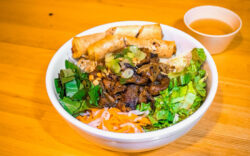FOOD THAT YOU DESIRE: That’s what the name of Mannaweenta Ethiopian Restaurant (706-352-8242) means, and it’s well chosen. African food has long been a lacuna in the culinary scene of Athens. For a while, you could get some really tasty food at the African Caribbean Asian International Market on Gaines School Road, including a thick and marvelous dish of boiled okra and a wonderful peanut-based stew, but it closed.
For now, Mannaweenta isn’t exactly a restaurant, but its owner, Hergu Bahtu, has plans to make it into one. To eat her food until she opens a brick-and-mortar location (she has her eye on the former Viva Argentine space on the Eastside), you’ll have to visit the West Broad Farmers Market on Saturdays, when it runs from 10 a.m.–2 p.m. at 1573 W. Broad St. Browsing the booths is a pleasant experience, with music going in the background, some folks playing chess, yoga happening in a field and so on, but you can also head straight to Bahtu’s table and get yourself a Styrofoam container heavy with enough food for two meals for a mere $9.
On a recent Saturday, the main dish was yebere tibbs, or beef tips cooked until tender with onions, tomatoes, green pepper, garlic, ginger and herbs. Rather than picking at it with a fork, tear off a piece of injera (a flat, spongy, slightly sour bread made of teff flour that more closely resembles a large pancake) and use it as your eating utensil, wrapping the meat or veggies and soaking up their delicious sauce. Eaten on its own, injera can be an acquired taste, but it’s meant to marry with the rest of the food, and that sourness adds an important flavor note and ensures nothing goes to waste.
Sides include atakilt alitcha (mixed vegetables cooked with garlic, jalapeno and herbs, which could serve as a main dish for vegetarians), gomen wot (collards chopped fine and seasoned with tomato, garlic and onions) and red lentils (cooked into a stew and seasoned with—wait for it—tomato, garlic and onions). The list of supplemental ingredients may sound repetitive, but the results in reality are not. Each dish has enough in common with its neighbors to combine well with them but maintain a distinct identity.
When the restaurant gets going, you can expect to find East African specialties including kitfo (finely chopped beef, traditionally served raw or rare, mixed with clarified butter and pepper), doro wot (chicken stew with hard-boiled egg), lamb and baked fish, as well as spaghetti and lasagna, due to the fact that Italy had a number of colonies in the area. Everything is delicious, satisfying, fun to eat and thoroughly worth your time. The menu at the market is small but variable.
FLOWERING: A recent trip to Savannah happened to coincide nicely with the opening of Hugh Acheson’s latest project, The Florence (1-B W. Victory Drive, 912-234-5522), which occupies a building that was formerly an ice factory and has been renovated into a fancy yet still industrial mixed-used complex. Kyle Jacovino, who ran Five & Ten for a few months, has the kitchen, and his expertise in Italian cuisine forms the basis of the menu; Chris Wilkins, formerly of Independent Baking Co., is doing bread; and Allison Crumpton, who started out at Five & Ten, is both general manager and wine director.
It’s early yet, and, at least in the upstairs bar, where one can eat more informally, the staff were still figuring out what constituted a station or where the extra beverage napkins were, but, on the whole, the place was in great shape. The dining space downstairs has its own bar and is large without being cavernous, lit with wonderful fixtures. A coffee bar is off to the right.
Jacovino’s abilities with charcuterie were notable during his time in Athens, and they haven’t slipped. The salumi plate is worth the $26 for three options, featuring, on this visit, housemade mortadella (served in warm slices with pasta fritta and a grapefruit-accented whole-grain mustard), country terrine (with pickles) and ciccioli (a sort of fried pocket of squeezed and aged pork fat, which is much better than it sounds, served with fennel slaw).
The bread plate includes focaccia, sesame-crusted breadsticks and slices of pain de campagne, served with excellent butter. The grilled sourdough that accompanies the bruschetta “grande,” a.k.a. a lovely little jar of chicken liver pâté topped with a slightly too-thick layer of balsamic jelly, may be even better, smoky and redolent of BBQ. The black bucatini, which comes with a tomato-based sauce studded with Sapelo clams, Tybee shrimp and nuggets of garlic sausage, might be better with a simpler, less bold sauce, considering how good the pasta is, but the mussels al diavola are stellar: enormous, plump, perfectly cooked in a fragrant broth (one quibble: a dish for the shells would help).
The cocktail program is doing good stuff, with a great take on a Pimm’s Cup that uses bourbon and ginger beer and something pretty called a Mio Caro (gin, Aperol, strawberry, lemon, prosecco). There is much more to explore, including pizzas and flights of vermouth.
Like what you just read? Support Flagpole by making a donation today. Every dollar you give helps fund our ongoing mission to provide Athens with quality, independent journalism.









